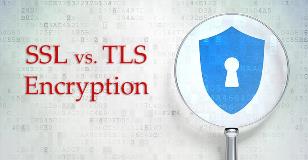The evolution from SSL (Secure Sockets Layer) to TLS (Transport Layer Security) symbolizes a significant transformation in the landscape of internet security. This transition, likened to a modern-day Exodus, not only fortified the digital realm but also prompted a profound reflection upon our covenant with technology, especially from a Christian perspective.
The advent of the internet ushered in an era of unfettered communication, permitting the rapid exchange of information across geopolitical boundaries. However, as this virtual cosmos burgeoned in complexity, it beckoned the specter of insecurity. For Christians, who subscribe to the belief that wisdom is paramount, the initial implementation of SSL in the mid-1990s represented a step toward creating a divine shield, albeit one laden with vulnerabilities. SSL was good, but it proved to be frail, susceptible to the machinations of cyber threats and adversarial entities.
Just as the Old Covenant was rendered insufficient with the arrival of the New Covenant, so too did SSL become obsolete. In doing so, TLS emerged as a beacon of hope. What set TLS apart from its predecessor? The introduction of stronger encryption algorithms, improved authentication mechanisms, and enhanced integrity checks marked a pivotal upgrade. In a spiritual sense, this mirrors the call for Christians to seek greater fidelity and honesty in their relationships—both with God and one another. Just as the quality of our commitments matters, so too does the strength of our digital safeguards.
Moreover, TLS encapsulates a crucial dichotomy. It reflects the duality of grace and truth—providing a secure environment where data can flow freely while ensuring that authenticity remains uncompromised. This resonates with the Christian ethos of fostering meaningful connections built on trust. E-commerce, online communication, and data sharing have flourished due to the robust nature of TLS, nurturing a digital ecosystem where individuals can engage in commerce without the looming specter of fraud. This adherence to ethical standards is akin to the Biblical exhortation to love one’s neighbor as oneself, emphasizing integrity in all interactions.
In an era rife with cyber warfare and misinformation, transitioning to TLS has carved pathways for a more righteous digital experience. With the dawn of TLS 1.2 and subsequently TLS 1.3, Christians are reminded of the need for evolution and adaptation in their spiritual journey. Each iteration of TLS ushers in promises of greater security, reflecting the continual process of sanctification—a journey towards holiness and righteousness. Just as believers are called to shed their old selves, so too did the internet require an overhaul to combat the winds of digital peril.
The relationship between SSL and TLS serves as a metaphor for regeneration. SSL had its place, functioning as a temporary measure in a nascent digital universe. However, as the Apostle Paul articulated in 2 Corinthians 5:17, “Therefore, if anyone is in Christ, the new creation has come: The old has gone, the new is here.” TLS embodies this new creation, establishing a fortified foundation upon which a secure internet can be built.
Furthermore, the intricate architecture of TLS can provoke deeper contemplation on the divine order of creation. Layered security protocols—such as key exchange mechanisms, cipher suites, and digital certificates—illustrate the profound complexity inherent in safeguarding digital interactions. This complexity beckons admiration akin to the awe-inspiring intricacies found within God’s creation. Just as believers are called to study and understand the wonders of the universe, designers and cryptographers have approached TLS with a dedication to detail, replete with the intention to protect and serve.
However, the ascendance of TLS is not without its challenges. Obstacles ranging from user ignorance to the costs of implementation pose significant hurdles. Yet, the Biblical story of perseverance through trials encourages Christians to confront these impediments with tenacity. Just as the Israelites faced the Red Sea, only to witness the miraculous parting, so too must modern believers navigate through the sea of digital insecurity with faith in the future of secure communication.
Additionally, the implementation of TLS invites reflection on the broader implications of ethical stewardship. As Christians engage with the digital world, they are called to not only practice good, but also to advocate for the enforcement of strong security measures. The right use of technology is a divine imperative; utilizing TLS reflects a commitment to safeguarding the sanctity of data against nefarious actions. It beckons all to re-examine technology as not merely a tool, but an extension of one’s stewardship over creation.
In conclusion, the transition from SSL to TLS is not merely a technical upgrade; it is an awakening—a reminder of the responsibility that comes with progress. It beckons a shift in perspective toward a more profound understanding of our digital interactions. Christians are called to engage with this evolution thoughtfully and critically, ensuring that the technological advancements made resonate with the teachings of Christ. TLS is not just about encryption; it is about creating a secure haven where faith and truth can triumph in the digital age. In a world brimming with uncertainty, the transition from SSL to TLS stands as a metaphorical pillar—a triumph for both security and integrity in the realm we now inhabit.









Leave a Comment